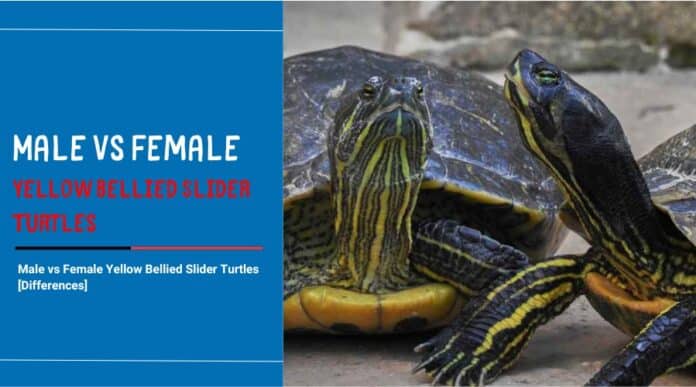Ever wondered about the differences between male and female Yellow Bellied Slider turtles? Struggling to determine their sex? This blog post is your ultimate guide to “male vs female Yellow Bellied Slider turtles”. Join us as we delve into the fascinating world of these turtles and understand why sex differentiation is so crucial. Don’t miss out!
General Characteristics of Yellow Bellied Slider Turtles
The Yellow-Bellied Slider (Trachemys scripta scripta) is a fascinating reptile that enhances the wetlands of the southeastern United States with its vibrant presence. Let’s explore the general characteristics of these aquatic explorers, including their distinctive appearance, natural habitat, and intriguing behaviors.
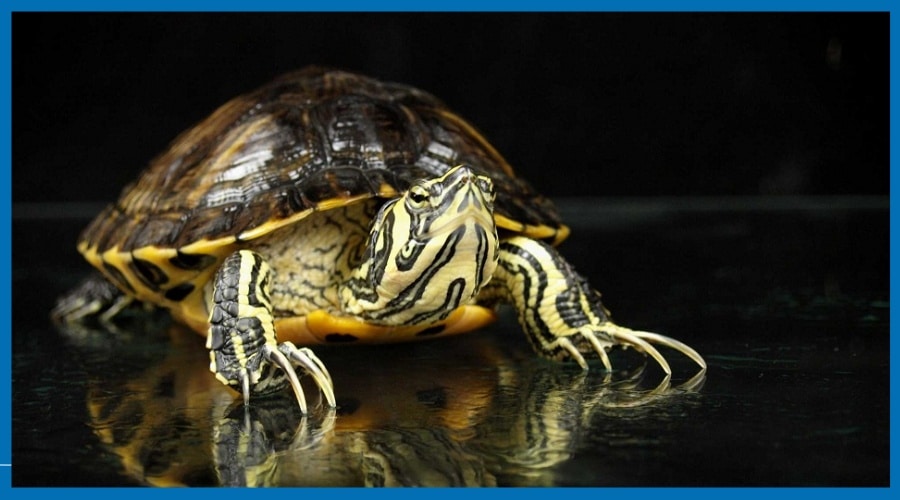
Appearance
- Carapace: The upper shell, or carapace, displays a beautiful array of olive, brown, and black shades, often decorated with intricate yellow stripes. These stripes, particularly noticeable in juveniles, fade with age, transitioning to a more subdued pattern.
- Plastron: The underside, or plastron, is typically yellow, giving the turtle its name. Some individuals may even exhibit intricate markings on their plastron, adding to their unique allure.
- Skin: The skin is a vibrant olive green, further highlighted by bold yellow patches on the neck and legs. These yellow patches, especially visible when basking, contribute to the turtle’s overall radiant appeal.
- Size: Males are generally smaller than females, with a carapace length of around 5-9 inches (13-23 cm), while females can grow up to 8-13 inches (20-33 cm).
Natural Habitat
- Slow-moving rivers and streams: They navigate the gentle currents with ease, basking on logs or emergent rocks.
- Sun-dappled ponds and lakes: These provide ample opportunities for basking, foraging, and evading predators.
- Cypress swamps and marshes: The dense vegetation offers shelter and breeding grounds, making them ideal habitats for these semi-aquatic turtles.
Habits and Behavior
Habits and Behavior: Masters of Aquatic Acrobatics Yellow-Bellied Sliders are adept swimmers, propelling themselves through the water with powerful legs and webbed feet. They spend most of their time basking on logs or rocks, absorbing the sun’s warmth to regulate their body temperature. However, these charismatic creatures are more than just lazy sunbathers. They are also:
- Agile climbers: Their strong claws enable them to scale rocks and logs with ease, reaching prime basking spots or escaping potential dangers.
- Omnivorous opportunists: Their diet includes a diverse range of prey, from aquatic insects and fish to succulent plants and algae.
- Social butterflies: While primarily solitary, Yellow-Bellied Sliders can form loose aggregations during basking or breeding periods.
Characteristics of Male Yellow Bellied Slider Turtles
While both sexes share the captivating charm of Yellow-Bellied Sliders, male turtles possess a unique set of characteristics that distinguish them. Let’s delve into the world of these aquatic gentlemen, exploring their distinct size, shape, specialized reproductive features, and intriguing behaviors.
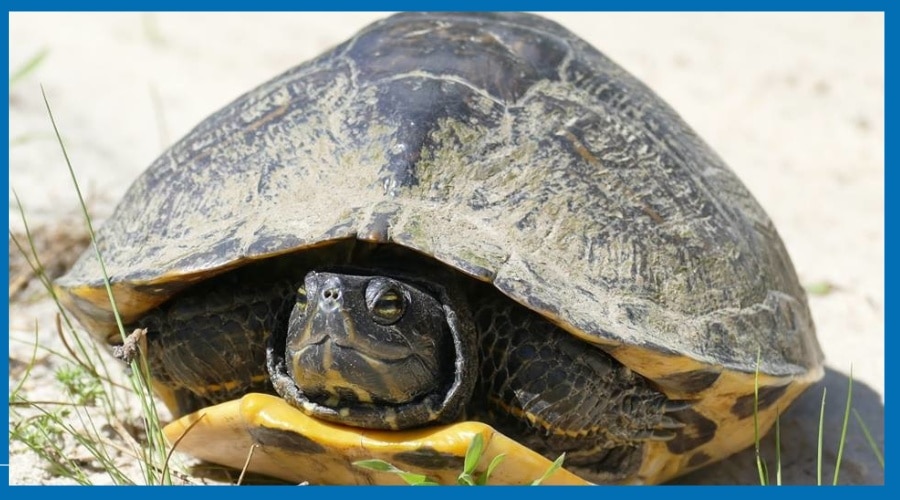
Size and Shape
- Smaller Stature: Compared to females, male Yellow-Bellied Sliders are noticeably smaller, typically reaching a carapace length of 5-9 inches (13-23 cm), as opposed to a female’s 8-13 inches (20-33 cm).
- Narrower Shells: Their carapaces tend to be narrower and more streamlined than females, facilitating greater agility and maneuverability in the water.
- Longer Tails: Their tails are relatively longer and thicker, extending beyond the carapace. This is particularly noticeable during the breeding season, as the tail plays a crucial role in courtship and mating.
Reproductive Features
- Claws on Forelimbs: Male Yellow-Bellied Sliders possess elongated claws on their forelimbs. These specialized claws aid in courtship, allowing them to grip onto the female’s carapace during mating.
- Elongated Cloaca: Located at the base of the tail, the cloaca houses the reproductive organs. In males, the cloaca is elongated and protrudes further than in females, facilitating successful sperm transfer during mating.
Unique Habits and Behavior
- Head-Bobbing Display: During courtship, males engage in a captivating head-bobbing display. With their necks outstretched and mouths slightly agape, they bob their heads repeatedly, attracting the attention of potential mates.
- Nudging and Biting: After a successful head-bobbing display, males may gently nudge or even nibble on the female’s head and neck, further encouraging her acceptance.
- Pursuit and Persistence: If a female is receptive, the male may pursue her relentlessly, chasing her through the water until she allows him to mount for mating.
- Competitive Spirit: Males can be fiercely competitive when vying for a female’s attention. Chasing, nudging, and even biting competitors are not uncommon during the breeding season.
Characteristics of Female Yellow Bellied Slider Turtles
While their male counterparts exude a certain dapper charm, female Yellow-Bellied Sliders possess a unique regal elegance that commands respect and admiration. Let’s explore the world of these wetland queens, examining their larger stature, specialized reproductive features, and fascinating behaviors that illustrate their unique allure.
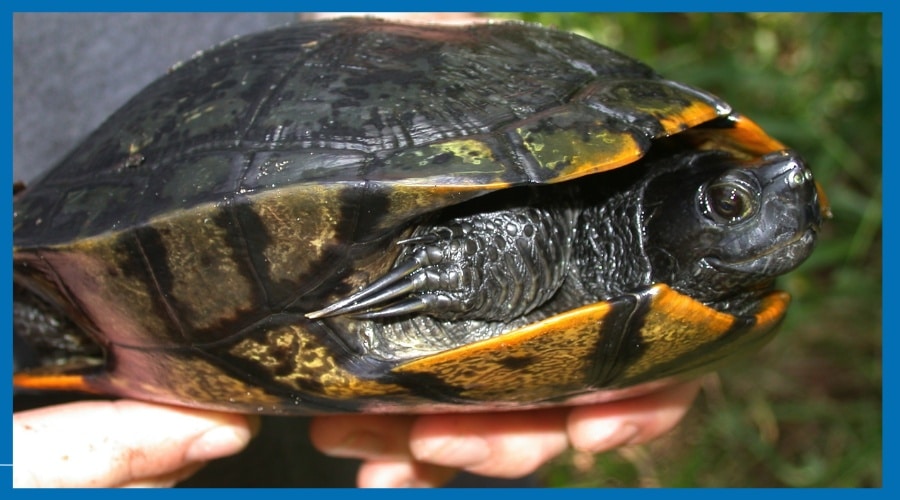
Size and Shape
- Imposing Presence: Compared to males, female Yellow-Bellied Sliders are noticeably larger, reaching a carapace length of 8-13 inches (20-33 cm) compared to a male’s 5-9 inches (13-23 cm). Their larger size reflects their critical role in carrying and laying eggs.
- Broader Shells: To accommodate the demands of reproduction, females have wider and deeper carapaces, providing ample space for developing eggs and ensuring their safety.
- Shorter Tails: In contrast to males, female tails are shorter and narrower, offering stability and balance during egg-laying journeys.
Reproductive Features
- Cloaca Placement: Compared to males, the female cloaca is located closer to the base of the tail, facilitating the laying of fertilized eggs.
- Nest-Building Instincts: Females possess a strong nesting instinct, prompting them to dig elaborate burrows in soft soil near water bodies, ensuring the optimal environment for egg development.
- Clutch Size: Depending on their size and age, females can lay multiple clutches of 5-12 eggs throughout the breeding season.
Unique Habits and Behavior
- Selective Suitors: Females are discerning when choosing mates. They often select larger, dominant males with longer claws, indicating successful hunting abilities and suitability for fatherhood.
- Mating Behavior: While males initiate courtship, females ultimately control the process. They can choose to accept or reject a male based on his displays and persistence.
- Nesting Journeys: Prior to laying eggs, females embark on arduous journeys, often venturing far from their usual aquatic environments to find suitable nesting sites.
- Protective Mothers: Even though they show minimal parental care after laying eggs, females exhibit surprising loyalty to their chosen nesting sites, often returning year after year to lay in the same location.
Comparison Between Male and Female Yellow Bellied Slider Turtles
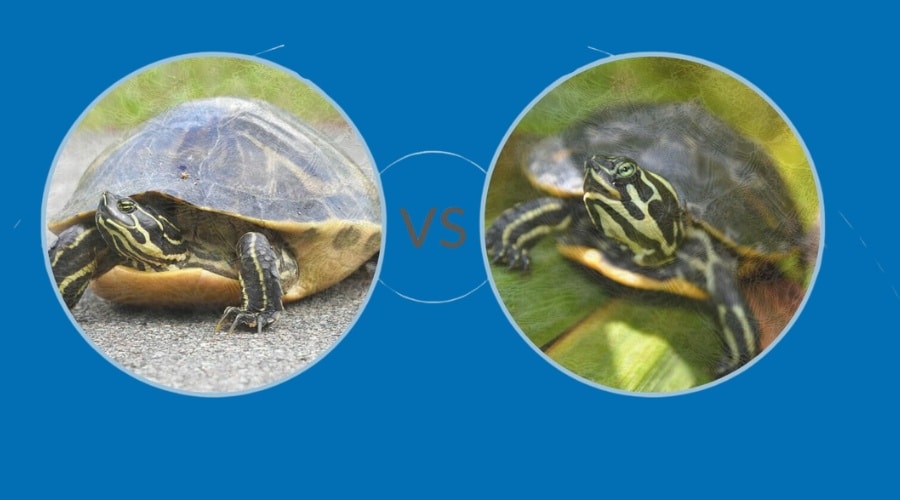
| Characteristics | Male Yellow-Bellied Sliders | Female Yellow-Bellied Sliders |
| Size and Shape | ||
| Stature | Compact and streamlined, reaching 5-9 inches (13-23 cm) carapace length | Imposing and broad, reaching 8-13 inches (20-33 cm) carapace length |
| Shell Shape | Narrower and more rounded for agility | Wider and deeper to accommodate developing eggs |
| Tail Length | Longer and thicker, aiding in courtship and mating | Shorter and narrower for stability during egg-laying |
| Reproductive Features | ||
| Claws | Elongated claws on forelimbs for gripping during mating | No elongated claws |
| Cloaca | Elongated and protruding for sperm transfer | Located closer to tail base for egg laying |
| Reproductive Organs | Internal testes | Internal ovaries and oviducts for egg development |
| Habits and Behavior | ||
| Courtship | Initiate with head-bobbing displays, nudging, and chasing | Selective, choosing suitable mates based on displays and persistence |
| Mating | Persistent and competitive, vying for female attention | Control the process, accepting or rejecting suitors |
| Nesting | Play no role in nest-building or egg laying | Embark on arduous nesting journeys, laying multiple clutches throughout the season |
| Parental Care | None | Show minimal parental care after laying eggs but exhibit loyalty to preferred nesting sites |
Guide to Caring for Yellow Bellied Slider Turtles
Yellow-Bellied Sliders, with their vibrant patterns and graceful aquatic acrobatics, have become beloved companions for many reptile enthusiasts. However, welcoming these wetland charmers into your home comes with the responsibility of providing them with a thriving and healthy environment. Let’s dive in as we explore the essential elements of Yellow-Bellied Slider care!
Habitat Requirements
Imagine your Yellow-Bellied Slider basking under a warm lamp, surveying their aquatic domain from a sturdy platform. To make this idyllic scene a reality, consider these key habitat requirements:
- Spacious Aquarium: An adult slider requires a sizable aquarium, ideally no less than 75 gallons for one turtle and an additional 50 gallons for each additional resident. Remember, they’re active swimmers, so provide ample room for exploration.
- Land and Water Balance: Aim for a land-to-water ratio of 30:70. This ensures your slider has dedicated basking space while keeping the swimming area spacious.
- Basking Platform: This is a crucial element! Choose a sturdy, waterproof platform that slopes into the water for easy access. Ensure it’s positioned under a heat lamp to offer a warm basking spot.
- Heating and Lighting: Mimic the natural sunlight cycle with UVB lighting for 12 hours daily. Provide a basking lamp emitting temperatures around 90-95°F (32-35°C) for your slider to thermoregulate.
- Water Filtration: Invest in a high-quality filter to keep the water clean and prevent ammonia buildup, which can be detrimental to your turtle’s health. Regular water changes are still essential, aiming for 25% weekly replacements.
- Substrate: Opt for smooth, rounded pebbles or aquarium sand for the bottom of the water area. Avoid sharp gravel that could injure your turtle’s delicate underbelly.
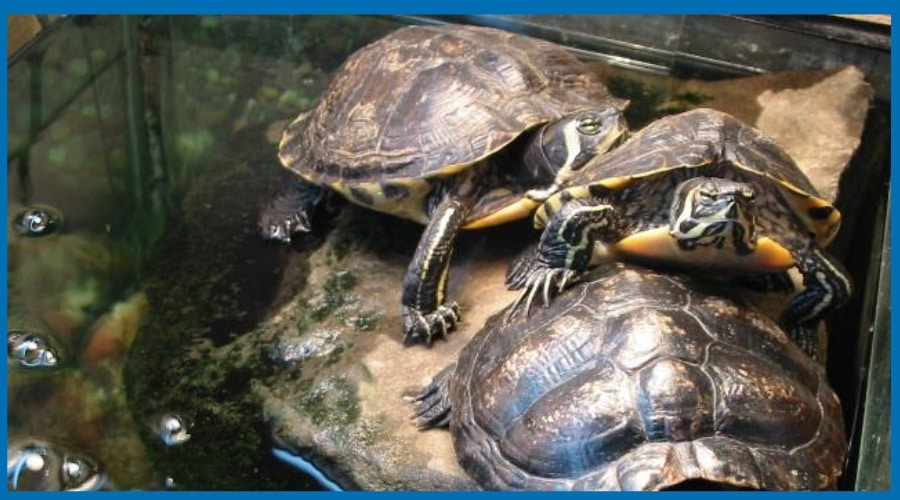
Diet
Like their omnivorous nature in the wild, captive Yellow-Bellied Sliders thrive on a diverse diet:
- Commercial Pellets: Choose high-quality turtle pellets formulated for balanced nutrition. Offer them daily as the staple food.
- Fresh Greens: Supplement their diet with a variety of leafy greens like romaine lettuce, collard greens, and dandelions for essential vitamins and fiber.
- Fruits and Vegetables: Offer occasional chopped fruits and vegetables as treats, including apples, carrots, and melons.
- Protein Sources: Cater to their natural hunting instincts with feeder fish, insects like crickets, and occasional lean meat or fish pieces. Remember, adjust the portion sizes based on your turtle’s age, size, and activity level. Avoid overfeeding, and maintain a clean feeding dish to prevent water contamination.
Health Care Tips
Preventive care is key to keeping your Yellow-Bellied Slider healthy and happy:
- Regular Veterinary Checkups: Schedule annual checkups with a reptile veterinarian for comprehensive health assessments and parasite screenings.
- Water Quality Monitoring: Regularly test the water parameters for pH, ammonia, and nitrite levels. Maintain optimal levels to prevent health issues.
- Hygiene and Cleanliness: Thoroughly clean the aquarium’s decorations and substrate periodically to avoid bacterial growth.
- Environment Enrichment: Provide your slider with mental stimulation! Offer floating toys, hiding places, and varied vegetation to keep them engaged and active.
Conclusion
We hope that through this blog, you’ve gained a deeper insight into “male vs female yellow bellied slider turtles” and have a better understanding of the notable differences between them. Don’t hesitate to explore our other blogs from the National Park Aquarium to learn more about the wonderful world of turtles and other creatures.

